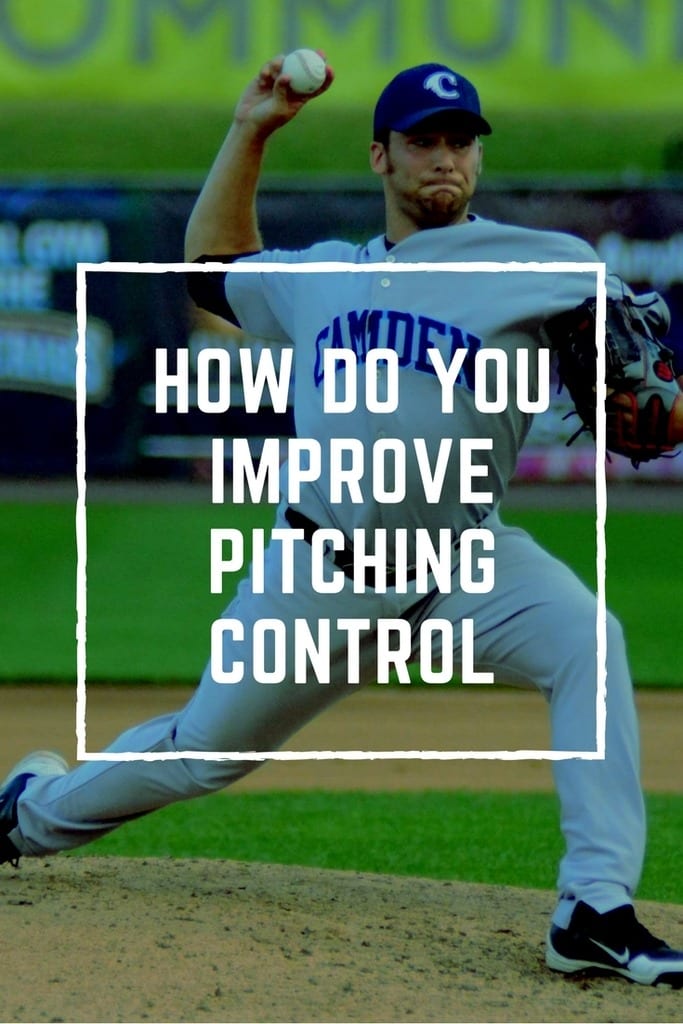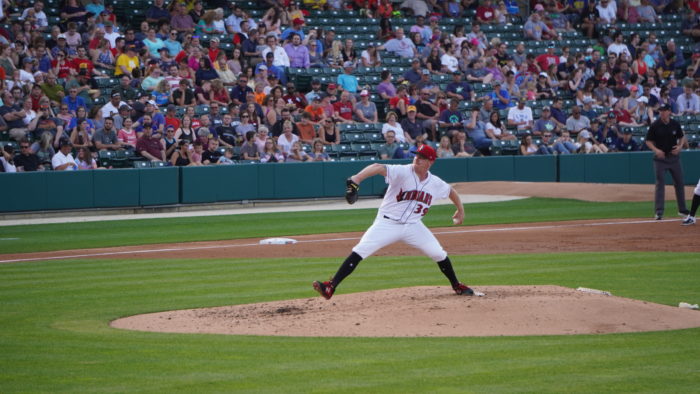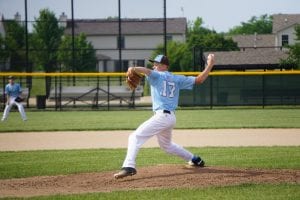*This article may contain product links which pay me a small commission if you make a purchase. Learn more.
Pitcher A takes the mound and goes 7 innings with 1 walk and 5ks.
Pitcher B takes the mound and goes 7 innings with 4 walks and 5ks.
Why does Pitcher A throw more strikes and have better control?
First, Pitching Mechanics Play a Role.
But it’s only a piece of the pie.
If you want to learn more about pitching mechanics, an improved delivery can certainly improve your command.
But, it’s NOT all about mechanics, as humans aren’t robots. There’s more than just getting your joints and limbs into the right position.

You Can Have Superb Control With Weird Pitching Mechanics.
Here’s one thing we know for sure: Every pitcher has different mechanics, and it doesn’t necessarily correlate with control, and we can look to countless examples of a pitcher who has (insert mechanical quality here) who either does or does not have good control.
- You can have excellent control with a high leg kick.
- You can have excellent control with a low leg kick
- You can have excellent control with a short stride
- You can have excellent control with a long stride
- You can have excellent control striding straight
- You can have excellent control striding across your body
- You can have excellent control with your eyes locked on the mitt
- You can have excellent control with your eyes not locked on the mitt
The problem is that mechanics do a lot of things, but they don’t ensure the ball goes where it’s supposed to go. How that ultimately happens is more complex and isn’t easily understood or trained. Really, it’s “feel -” the interaction between your mind, your mechanics and the way the ball leaves your fingers.
Do Good Pitching Mechanics Account for Good Control in Baseball?
“Pitching mechanics” all sum into one final act:
- Delivering the hand that’s holding the baseball.
If a pitcher is trying to hit the same target over and over with a fastball, then the goal is to have the fingers apply their force to the same exact spot of the ball, in the same direction, with the hand in the same position in space at the same velocity and trajectory. If he does this, the throw will be accurate relative to the target.
But, if he misses – what happened?
If you watch a pro pitcher in slow motion, regardless of whether he walks 2 batter per 9 innings or 5 batters per 9 innings, you’ll see the same motion – they look identical.
Pro Pitchers Are in Touch with Their Bodies.
What I mean by that is, “mechanics” are almost identical from one pitch to the next. This is almost as true for 13-year olds as it is for professionals. The reason one throws a ball isn’t because they strided to a different location, or pulled their front side way out. It sometimes is, but not usually; it’s more subtle than that. There isn’t usually a glaring reason that a ball was thrown rather than a strike.

And, simply “not pulling your front side out too soon” on the next pitch does not guarantee the ball will go where it should have gone. It still comes down to the hand, which can move independently of the rest of the mechanics.
Really, the pitchers with the best control, at any level, just find a way to get their hand and fingers into the exact same position every time. Then, when they throw to a different location, they somehow know where their hand and fingers have to be to get the ball to go there. How does this happen? I don’t exactly know, but I know how it feels.
Full-Speed Target Throws: Do They Improve a Pitcher’s Command?
For those who don’t have good in-game control, throwing as hard as you can at targets, as a primary developer of control, doesn’t make a lot of sense. Why? Because it’s what you do in the game and you’ve already proven you can’t do it effectively. Pitchers with poor control, as seen in a game, are poor at the following task:
– Throwing at full-speed to a target. (Right?!)
So if a pitcher throws 100+ innings in a season and walks too many batters, he’s proven that throwing to a target at full-speed is a task he fails at, because thats exactly what pitching is.
Though I agree that practicing the same as you would in a game is generally a good idea, it becomes a not good idea when you continue to fail at it. To make progress you have to slow the speed down, improve feel for location, then reintroduce higher speeds. If a kid can’t swim, you don’t just throw them in the ocean. They’ll drown.
So, spending an off-season throwing as hard as one can at targets, or a catcher, isn’t the way to improve it. If it was, it would have improved as the season wore on.
Rather, we need to take a step back, reduce velocity and learn to feel one’s mechanics, hand position, etc and learn how each pitch should feel when it releases off the hand and does to a location. Get better at locating. Then, we gradually increase speed and repeat.
The Reason: High-Speed Pitching Is GO Time, Not LEARN time.
High-speed movements are the hardest to control. At high-speed, the body moves reflexively and in what it thinks is the most efficient way. From experience, it’s very, very hard to control hand-position at full-speed.
If I want to throw more strikes, I need to know how it feels to release a pitch so that it goes to the location that I want. I need to teach my brain and hand to work together to replicate that feel. Every time I want “pitch-location 14,” my hand needs to be delivered to “pitch-location 14” position. Somehow, I do know how to throw a cutter low and a way, then throw a four-seamer up and in. My brain works with my body to get the my hand into the catalogued position required to deliver the ball to that spot, then the next, then the next.
To increase this connection requires low-speed repetitions. At lower-speeds (velocities at 60-90% of one’s max) the differences in hand position on each throw can be easily felt and more easily corrected.
So, if one tries to throw his slider low and away, at lower speeds he’ll be able to feel the difference in his hand and finger position on a slider that goes to the correct spot, versus one that misses. Sometimes, there’s mechanical faults too. Those must also be felt and corrected. But, with mechanical faults or not, the hand is what’s ultimately going to make or break the pitch. You can learn to locate while still flying out with your front shoulder, for example, though it’s not recommended to pitch that way.
Problem: Most Pitchers Don’t Pay Attention
As a 29-year old pitcher, I’m still learning to pay better attention. I’m still trying to improve my control, and it isn’t easy, especially when I have had to return from missed seasons due to injury. Time off fades the mind-body connection.
The problem with most pitchers (and past versions of myself) is that they don’t pay attention. They just grab the next pitch and throw it. They throw in the offseason without paying enough attention to how each pitch feels off their hand.
Pitchers With Great Control are Great Mentally.
Good control is ultimately a mental connection that continues to strengthen with attention paid between mechanics, hand position and feedback. Once your mechanics do mostly the same thing every time, it’s about paying attention to where each pitch goes, how it feels releasing off the hand. The interaction between the location and the feel is where you learn why you missed your spot and how to correct it.
Every day that I get better at feeling when my hand position is at fault, or when my elbow drops on a change up, or when I ease off my finish of a curveball, is a day that I’m setting myself up to throw more strikes in the summer.
Every day that I throw while my mind is elsewhere, or I throw 5 pitches in a row into the wrong location without correction, or I threw as hard as I could with no regard to location (though necessary in the correct doses) is a day I got stupider and worse as a pitcher.
What Pitchers Tend to Have Good Control?
Pitchers with the best control tend to be:
- Ones with lower velocity
- Older
- Methodical by nature
- Quieter, smarter, more precise by nature
The above are generalizations, but the more players I think about that I have coached, played with and against, the list holds mostly true.
- Pitchers with excellent velocity are more likely to overthrow and ignore the reasons they miss their locations. Pitchers with lower velocity are forced to learn to be effective by locating, so they get better at it by necessity. This is the story reported by many MLB pitchers whose velocity faded as they aged or after they suffered an injury. They didn’t have to locate before, but when the velocity no longer allowed consistent missed spots, they were forced to learn.
- Older pitchers learn the value of control and thus spend more time working on it (per the methods I’ve expounded upon in this article). Older, wiser pitchers realize how important control is and work harder to improve it.
- Methodical, quiet, smart pitchers spend more time analyzing pitching in its finer qualities – locating, changing speeds, using effective sequences. They pay more attention to the feedback needed to have great control because of it.
So, How Do You Improve Pitching Control?
- Determine the speed at which you fail to locate as well as you’d like.
- Back it down and get as many throws, at lower speeds, as possible
- Pay attention to mechanics and hand position as they pertain to causing successfully located pitches and misses
- Using the feedback loop, attempt to correct every miss
- Gradually increase velocity
- Repeat steps 1-4 until they’re performed, in practice, at 100% velocity again
- Note that to make progress, thousands of lower speed throws will be required.
Need More Help Learning How To Throw New Pitches?
Sign up for my Pitchers’ Development Checklist and get on my email list – I’ll be sending new content weekly that you can keep learning the game.


